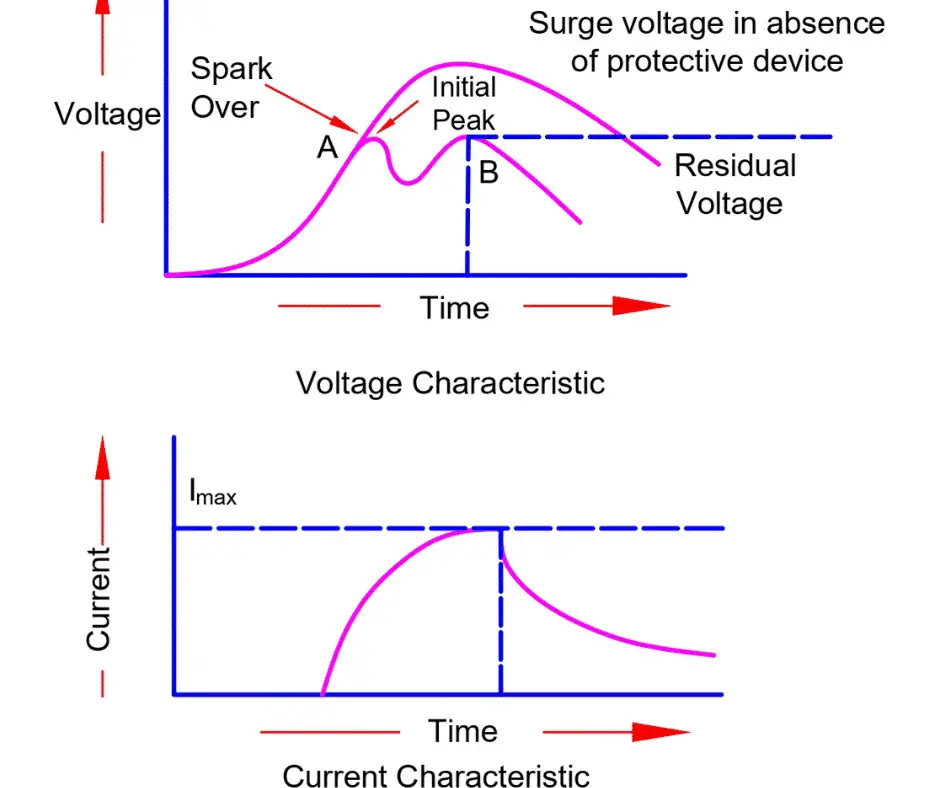Lightning Arrester is a device used for the protection of electrical equipment against lightning stroke. The lightning stroke is the high voltage transients caused by the traveling waves during lightning. We install lightning protection devices to protect the transformer, transmission line, and the major electrical equipment.
The electrical equipment is prone to damage against the transients, impulse, surge voltage, and lightning voltage induced in the transmission line at the time of lightning or fault in the electrical network.

If there is no protection system against these induced high voltages, it can cause damage to the electrical equipment and the longer disruption of the power supply.
Definition of Lightning Arrester:
The protective device used for protection of the electrical equipment against any power surges caused by lightning impulse voltage and surges is a lightning arrester or surge arrester. We install the lightning arrester between the line and the earth. Thus, its location is in parallel with the equipment.
The lightning arrester provides the low impedance path for those frequencies which differ from the power frequency. The surge voltage finds its path to the earth through the arrester. Thus, electrical equipment remains protected. The surge impedance of the line provides impedance to limit the current.
The traveling wave can cause superimposition of high voltage over the power frequency and it may cause severe damage to equipment along with power outage.
Damages Caused by Lightning Wave
Electrical equipment like transformers, motors have the capacity to sustain the voltage up to its maximum breakdown insulation level(BIL). If the voltage of more than BIL appears across the equipment terminal, it can cause the failure of the equipment caused by insulation failures. The peak voltage increases at the time of the lightning, and it may cause flash-over in the equipment like a transformer, motor, and transmission line. The direct stroke of lightning induces a very high voltage in the transmission line and causes damage to the insulator and connected equipment to the transmission line.
Working of Lightning Arrester
The lightning arrester has a high impedance for power frequency. Thus, under normal operation, it behaves as an open circuit. In case of a lightning strike, there is a sudden rapid rise in voltage. Its resistance becomes very low for the lightning-induced voltage, the current finds its discharge path to the ground. After discharging the lightning surges, the arrester regains its resistance and behaves as an open circuit for power frequency.
The lightning arrester provides a path of low impedance for surges. It diverts the current to the ground and clamps the high voltage.
As shown below figure, the lightning voltage at point ‘A’ and point ‘B’ is
- Clamped at point ‘B’ – Low Voltage
- Not clamped at point’A’ – High Voltage

Characteristics of an Ideal Lightning Arrester
- The current through the lightning arrester should be minimum during normal operating condition. It should have high impedance for power frequency.
- The current must pass through it when there is surges, transients or lightning voltage.
- It must have capacity to handle the discharge current during abnormal condition without being damage.
- It must rebuild its insulation level for power frequency quickly after quenching of surge or travelling voltage.
Location of Lightning Arrester
We must install the lightning arrester as near as possible to the equipment for effective protection of the equipment against lightning and traveling waves. The arrester is installed between the line and the earth. For the three-phase system, we install three numbers arrester i- one arrester per phase. The arrester has wide application for protection of transformer, motor, generator, transmission line, etc.

The lightning arrester is located on both the high and low sides of the transmission line to protect the transformer against lightning strikes.